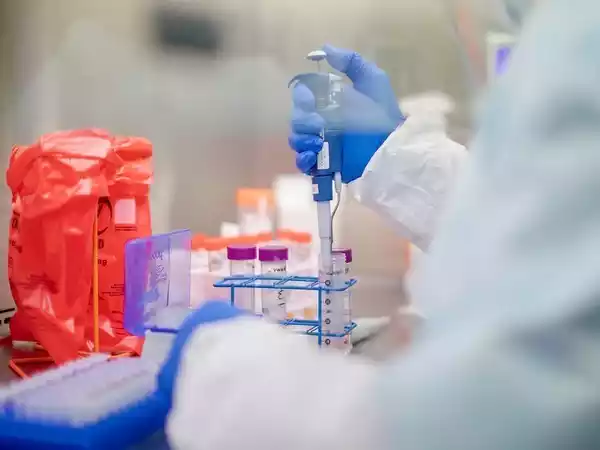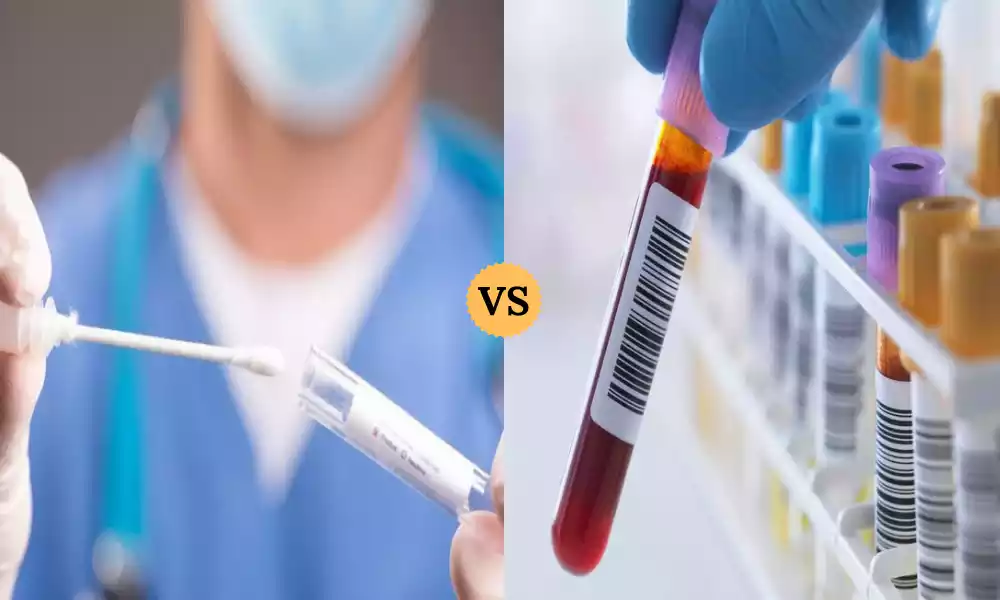Antigen and NAAT Tests are two essential diagnostic tests in healthcare, each serving distinct purposes. Antigen tests detect specific viral proteins, offering rapid results and cost-effectiveness but with lower sensitivity. NAAT tests detect the genetic material (RNA or DNA) of pathogens, providing high sensitivity and specificity but typically requiring longer turnaround times and greater costs.
Understanding the differences between these tests is crucial for healthcare professionals and individuals seeking accurate disease diagnosis and management. This guide explores the characteristics, advantages, limitations, and appropriate use cases of both antigen and NAAT tests to help navigate their roles in modern healthcare.
What is Antigen Test?

An antigen test is a diagnostic test used to detect the presence of specific viral or bacterial antigens in a person’s biological sample, such as a nasal swab or saliva. These tests are primarily employed to diagnose infections caused by pathogens like viruses (e.g., SARS-CoV-2, the virus responsible for COVID-19) or bacteria.
Key features of antigen tests include:
-
- Rapid Results: Antigen tests are known for their speed. They can provide results in as little as 15-30 minutes, making them valuable for quickly identifying infected individuals.
- Targeted Antigen Detection: Antigen tests are designed to detect the presence of specific antigens associated with a particular pathogen. For instance, in the case of COVID-19, the antigen test detects proteins from the SARS-CoV-2 virus.
- Sensitivity and Specificity: The accuracy of antigen tests can vary depending on the specific test and the stage of infection. While they are generally less sensitive than nucleic acid amplification tests (NAATs) like PCR, they are still valuable tools for early detection, especially when used in settings where rapid results are essential.
- Cost-Effective: Antigen tests are often more cost-effective than NAATs, making them a practical choice for widespread testing, mass screenings, and point-of-care testing.
- Use Cases: Antigen tests are commonly used for quick screenings, especially in settings like airports, schools, workplaces, and healthcare facilities. They can help identify potentially infectious individuals, even before they develop symptoms.
While antigen tests are useful for rapid detection, they may have a higher rate of false-negative results compared to more sensitive tests like NAATs. Therefore, in situations where accuracy is crucial, follow-up testing with a more sensitive method may be recommended, especially for confirming negative results or diagnosing individuals with symptoms or known exposure to the pathogen.
How Do Antigen Tests Work?
Antigen tests work by detecting specific viral or bacterial proteins (antigens) associated with a particular pathogen. These tests are commonly used to diagnose infections caused by viruses like SARS-CoV-2 (the virus responsible for COVID-19).
Here’s a simplified overview of how antigen tests typically work:
- Sample Collection: A healthcare professional collects a sample from the patient. For COVID-19 antigen tests, this sample is often obtained through a nasal or throat swab. The sample may also be collected as saliva.
- Sample Processing: The collected sample is then processed to extract any viral antigens present. This step may involve mixing the sample with a special solution to release the viral proteins.
- Antigen-Antibody Reaction: The processed sample is applied to a test strip or a well containing antibodies specific to the target viral antigen. If the viral antigen is present in the sample, it will bind to these antibodies.
- Visual or Instrument-Based Detection: The test results can be read visually, often within 15-30 minutes. In a positive result, a visible signal, such as a colored line on a test strip, appears, indicating the presence of the target viral antigen. Some tests may require an instrument for result interpretation, especially in more complex testing settings.
The underlying principle of antigen tests is immunoassay, where the interaction between antibodies and antigens forms the basis for detection. The antibodies used in the test are carefully selected to specifically recognize and bind to the target antigen of the pathogen being tested for. This interaction generates a detectable signal, such as a visible color change, that indicates the presence of the viral antigen.
While antigen tests are valuable for their rapid results and cost-effectiveness, they may have limitations, especially in terms of sensitivity. They might not detect the virus during the very early stages of infection or in cases where the viral load is low. In situations where high accuracy is crucial, especially for confirming negative results or diagnosing individuals with symptoms or known exposure, follow-up testing with a more sensitive method, such as a nucleic acid amplification test (NAAT), may be recommended.
What is NAAT Test?

A NAAT (Nucleic Acid Amplification Test) is a highly sensitive and specific diagnostic test used to detect the presence of genetic material (nucleic acids), such as DNA or RNA, from specific pathogens like viruses or bacteria in a person’s biological sample. NAATs are commonly used in clinical laboratories and are particularly known for their accuracy in detecting infections.
Key features of NAATs include:
-
- High Sensitivity and Specificity: NAATs are known for their exceptional accuracy. They can detect even small amounts of the pathogen’s genetic material, making them highly sensitive and specific. This accuracy is crucial for confirming infections, especially in cases where the pathogen is present in low concentrations.
- Targeted Genetic Detection: NAATs are designed to detect specific sequences of DNA or RNA unique to the pathogen being tested. This specificity allows for precise identification of the causative agent.
- Multiple Pathogens: NAATs can be developed to detect a wide range of pathogens, including viruses (e.g., HIV, hepatitis, COVID-19), bacteria (e.g., tuberculosis, Chlamydia, gonorrhea), and parasites (e.g., malaria).
- Laboratory-Based Testing: NAATs are typically performed in well-equipped laboratories by trained technicians. They require specialized equipment and reagents for the amplification and detection of genetic material.
- Turnaround Time: NAATs typically have a longer turnaround time compared to antigen tests, as they involve several steps of sample preparation, amplification, and detection. Results are usually available within hours to a few days, depending on the specific test and laboratory capacity.
- Diagnostic and Confirmatory: NAATs are often used for diagnostic purposes, especially when confirming infections in patients with symptoms or known exposure to the pathogen. They are considered the gold standard for many infectious diseases.
NAATs are crucial tools in clinical diagnostics and epidemiology, allowing for accurate and early detection of infectious diseases. They play a critical role in disease management, contact tracing, and public health efforts to control the spread of infections. Due to their complexity and longer turnaround times, they may not be as suitable for rapid screening in high-throughput or point-of-care settings, where antigen tests may be more practical.
How Do NAAT Tests Work?
Nucleic Acid Amplification Tests (NAATs) work by detecting and amplifying specific genetic material, either DNA (deoxyribonucleic acid) or RNA (ribonucleic acid), from pathogens like viruses or bacteria. These tests are highly sensitive and are commonly used for diagnosing various infectious diseases, including COVID-19, HIV, tuberculosis, and more.
Here’s a simplified overview of how NAAT tests typically work:
- Sample Collection: A biological sample is collected from the patient, typically through a swab of the nasopharynx, throat, or other relevant sites, depending on the suspected infection. The sample may also be collected as blood, urine, or other bodily fluids, depending on the test’s requirements.
- Sample Preparation: The collected sample is processed to extract and purify the genetic material (DNA or RNA) of the pathogen. This step involves breaking down the cells and separating the nucleic acids from other components in the sample.
- Nucleic Acid Amplification: In this crucial step, specific primers (short DNA or RNA sequences) are added to the extracted genetic material. These primers are designed to recognize and bind to specific sequences of the target pathogen’s genetic material. The test then uses a technique called polymerase chain reaction (PCR) or other amplification methods to make many copies of the target genetic material. This amplification step significantly increases the amount of the pathogen’s genetic material, making it easier to detect.
- Detection: Once the target genetic material has been amplified, it is detected using various methods. In some cases, fluorescent markers or probes are used, and the presence of amplified genetic material results in a fluorescent signal. This signal is then measured and interpreted as a positive or negative result. Some NAAT tests also use real-time PCR, which allows for continuous monitoring of the amplification process, leading to faster results.
- Result Interpretation: The test results are typically reported as positive, negative, or inconclusive. A positive result indicates the presence of the pathogen’s genetic material in the sample, while a negative result suggests its absence. Inconclusive results may occur if there are issues with the test process or if the amount of genetic material in the sample is very low.
NAATs are highly accurate and are considered the gold standard for many infectious disease diagnostics due to their ability to detect even small amounts of the pathogen’s genetic material. They are used in clinical laboratories and require specialized equipment and trained personnel for processing and interpretation. NAATs are particularly valuable for confirming infections, especially when the disease is at an early stage or when accurate results are crucial for patient management and public health interventions.
Comparison Table of Antigen and NAAT Test
Here’s a comparison table of Antigen and NAAT (Nucleic Acid Amplification Test) tests based on various key factors:
| Factor | Antigen Test | NAAT Test |
|---|---|---|
| Targeted Pathogens | Viruses (e.g., COVID-19) | Viruses, Bacteria, Parasites |
| Detection Principle | Detects viral antigens | Detects genetic material (DNA/RNA) |
| Speed of Results | Rapid (15-30 minutes) | Slower (hours to days) |
| Sensitivity | Lower sensitivity | High sensitivity |
| Specificity | Moderate specificity | High specificity |
| Cost | Cost-effective | Higher cost |
| Testing Location | Point of care or on-site | Laboratory-based |
| Appropriate Use Cases | Rapid screening and diagnosis | Confirmatory and diagnostic |
| Testing Volume | Suitable for high-throughput screening | Generally lower volume |
| Turnaround Time | Quick results | Longer turnaround time |
| False-Negative Rate | Higher potential for false negatives | Lower potential for false negatives |
| Use in Outbreaks | Useful for quick identification | Confirmatory and comprehensive |
| Follow-Up Testing | May require follow-up NAAT for confirmation | Typically not followed by another test |
| Testing Setting | Common in high-throughput settings, mass screenings, and point of care | Clinical laboratories, hospitals, and specialized facilities |
| Examples of Diseases | COVID-19, Influenza, Strep throat | COVID-19, HIV, Hepatitis, Tuberculosis |
| Public Health Impact | Valuable for rapid identification and isolation of cases | Critical for comprehensive disease surveillance and control |
| Screening vs. Diagnostic | Primarily for screening and initial detection | Primarily for confirmatory diagnosis |
This table provides the key differences between antigen and NAAT tests, highlighting their strengths and limitations in various aspects, including speed, accuracy, cost, and use cases. The choice between these tests depends on the specific clinical scenario, the need for rapid results, and the desired level of accuracy.
Conclusion
Antigen tests are efficient for rapid screenings and initial detection of infections, offering quick results at a lower cost. They may have lower sensitivity, leading to potential false negatives. On the other hand, NAAT tests excel in accuracy, making them vital for confirmatory diagnoses and comprehensive disease surveillance, albeit with longer turnaround times and higher costs. The choice between these tests depends on the specific clinical situation, balancing the need for speed and precision in disease detection.



